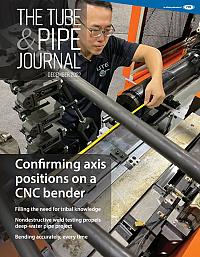Founder
- FMA
- The Fabricator
- FABTECH
- Canadian Metalworking
Categories
- Additive Manufacturing
- Aluminum Welding
- Arc Welding
- Assembly and Joining
- Automation and Robotics
- Bending and Forming
- Consumables
- Cutting and Weld Prep
- Electric Vehicles
- En Español
- Finishing
- Hydroforming
- Laser Cutting
- Laser Welding
- Machining
- Manufacturing Software
- Materials Handling
- Metals/Materials
- Oxyfuel Cutting
- Plasma Cutting
- Power Tools
- Punching and Other Holemaking
- Roll Forming
- Safety
- Sawing
- Shearing
- Shop Management
- Testing and Measuring
- Tube and Pipe Fabrication
- Tube and Pipe Production
- Waterjet Cutting
Industry Directory
Webcasts
Podcasts
FAB 40
Advertise
Subscribe
Account Login
Search
It’s time to consider a collaborative robot
Cobot technology has never been more accessible, and it can help even small shops fill labor needs
- By Lisa Wertzbaugher
- December 29, 2022
- Article
- Shop Management
Automation was the buzz going into FABTECH, the largest North American manufacturing tradeshow held in Atlanta in November. According to event organizers at FMA, publisher of The Tube & Pipe Journal and co-host of FABTECH, the Automation Pavilion has taken off in past years and was still booking space just weeks before show opening.
American manufacturers have been battling declining labor force numbers for more than 30 years, and every manufacturing tradeshow and conference has content focused on filling the skilled labor gap. Lots of strategies have been discussed and implemented—reaching out to students at a younger age, supporting trade programs, subsidizing trade school tuition—but it’s time to get more creative.
Even for small shops, the turn to robotics and automation is picking up speed. With the advent of collaborative robot (cobot) technology in the past 10 years, it is now easier, safer, and cheaper than ever to supplement human labor with automation. To understand more about the market for these devices, what’s driving it, and how to jump in, I talked with Mike Thomas, owner of Tube Form Solutions, a distributor of the JAKA cobot.
LW: What types of robots are available for manufacturing automation?
MT: The three main categories of robotic technology are collaborative robots, traditional high-speed robots, and robots specifically geared towards high-speed pick and place.
LW: What is a cobot? What’s the difference between that and a traditional robot?
MT: A cobot utilizes sensors so that it can work side by side with a human. Traditional robots are for high-speed applications and must be guarded with safety screening. Cobots operate at human speed and use pressure sensors for safety, so they shut off when they come in contact with a human.
LW: What is the No. 1 reason people are considering cobots?
MT: There are several benefits to cobot automation, but the biggest driver is the labor shortage. However, cobots also increase quality and reduce manufacturing costs. But most important, they fill open positions. There are jobs on a shop floor that are undesirable and have high turnover. That’s the first place we look when we analyze where to plug in a cobot.
LW: What is the smallest company you've worked with to implement automation?
MT: Now that cobot technology has entered the market, manufacturers of any size could benefit from implementation. We have put cobots into businesses with under a million dollars in annual revenue.
LW: I have zero automation on my shop floor right now. Where do I start?
MT: The first step is an automation assessment. An assessment doesn’t cost anything or take a lot of time, but it helps you determine how to use a cobot, how many you need, expected ROI, expected timeline from purchase order to green light, and more.
LW: How can I see and try products?
MT: Any U.S. distributor selling cobots will have demos on their showroom floor. You just need to reach out to a company and set up a site visit and tour. The next step is someone visiting your facility. It’s very similar to the process used when purchasing other types of machine tools.
LW: Do you recommend any automation seminars or conferences?
MT: FABTECH is obviously the big one. Automate is another large show focused exclusively on automation technology. It is held in Detroit and is scheduled for May 22-25,2023.
LW: What is the biggest challenge in going from manual labor to automated processes?
MT: The largest hurdle is getting employee buy-in. Often employees are worried about job security or are resistant to learning a new technology that is different from the way things have always been done. The key is to work with a good integrator. If the implementation and training is managed well, employees see the benefit early on and become automation champions.
LW: What is the price range for cobots?
MT: Cobots are sold either as individual units or as part of a workcell. An individual cobot ranges from $30,000 to $50,000 depending on the necessary accessories. A lean cobot workcell ranges $75,000 to $150,000. It’s inexpensive compared to other machine tools in the shop.
LW: What else should people know?
MT: There are a lot of grants and tax law benefits available right now for companies implementing automation technology. The government is realizing that manufacturing is a critical part of economic stability and growth. The U.S. should lead in this sector, and the biggest bottleneck will be labor. I highly recommend speaking with your local economic development organization and your accountant if you are considering cobots or other forms of automation.
About the Author

About the Publication
Related Companies
subscribe now

The Tube and Pipe Journal became the first magazine dedicated to serving the metal tube and pipe industry in 1990. Today, it remains the only North American publication devoted to this industry, and it has become the most trusted source of information for tube and pipe professionals.
start your free subscription- Stay connected from anywhere

Easily access valuable industry resources now with full access to the digital edition of The Fabricator.

Easily access valuable industry resources now with full access to the digital edition of The Welder.

Easily access valuable industry resources now with full access to the digital edition of The Tube and Pipe Journal.
- Podcasting
- Podcast:
- The Fabricator Podcast
- Published:
- 04/16/2024
- Running Time:
- 63:29
In this episode of The Fabricator Podcast, Caleb Chamberlain, co-founder and CEO of OSH Cut, discusses his company’s...
- Trending Articles
Team Industries names director of advanced technology and manufacturing

Orbital tube welding webinar to be held April 23

Chain hoist offers 60-ft. remote control range

Push-feeding saw station cuts nonferrous metals

Corrosion-inhibiting coating can be peeled off after use

- Industry Events
16th Annual Safety Conference
- April 30 - May 1, 2024
- Elgin,
Pipe and Tube Conference
- May 21 - 22, 2024
- Omaha, NE
World-Class Roll Forming Workshop
- June 5 - 6, 2024
- Louisville, KY
Advanced Laser Application Workshop
- June 25 - 27, 2024
- Novi, MI



























